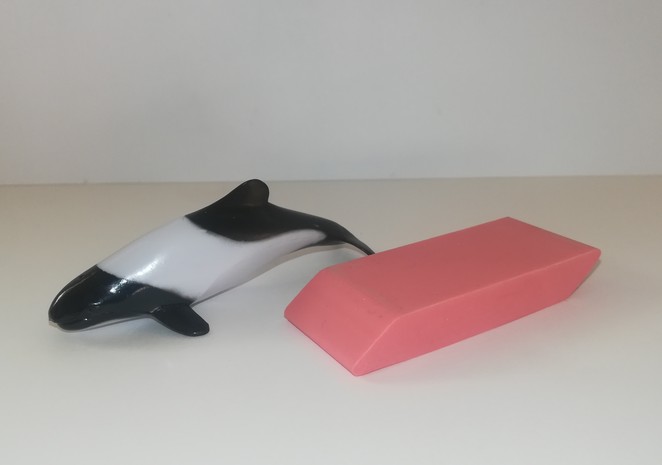Review and images by EpicRaptorMan; edited by bmathison1972
This small dolphin is known from an assortment of common names some of which include: the panda dolphin, skunk dolphin, jacobita, and Commerson’s dolphin, just to name a few. This cetacean was first described in 1767 by the French naturalist Dr. Philibert Commerson while exploring the waters around the southern tip of South America and was scientifically named Cephalorhynchus commersonii in 1804. Later, in the 1950s a subspecies (C. c. kerguelensis) was discovered near the Kerguelen Islands, an archipelago isolated in the southern waters of the Indian Ocean some 5,300 miles (8,500 km) away from South America.

Commerson’s colphins are often found in aquariums including Sea World and are quite active. These figures are based on C. c. commersonii and can be distinguished from the other dolphin subspecies thanks to their whiter coloration. I chose this model to be in my collection simply because I wanted a decent Commerson’s dolphin and unfortunately my options were limited. This figure is very small at a mere 2.75 inches (7 cm) long and ¾ inch (1.9 cm) tall at the dorsal fin. The real-life Commerson’s dolphin is in fact a small cetacean as they only reach lengths of 5 ft (1.5 m) or so, but this toy is a bit too small for my liking. It is noteworthy that seams are visible on either side of the body but the mouth, blowhole (a.k.a. spiracle), and eyes are sculpted yet are difficult to see given the toy’s overall size and black coloration on the head. Commerson’s dolphins don’t have beaks, known as rostrums, like other stereotypical dolphins but their mouths are slightly pointed unlike SeaWorld’s figure whose mouth is wide and rounded.

Overall, my biggest concern other than the size is the underside markings which are simply incorrect. Firstly, the black underside markings should connect the two pectoral fins and should end in a point leading towards the tail fluke. Second, the throat should be the only portion white; not the entire lower jaw. Third, there needs to be a black rounded spot (♀) or teardrop shape (♂) around the genital area. Finally, the black section just before the fluke should be less exaggerated.

So what do I think? I like the Commerson’s dolphin and I hope you learned something new today. I have four of these figures and after I complete a minor repaint to more accurately represent the underside I believe I will be more satisfied.

Disclaimer: links to Ebay and Amazon on the AnimalToyBlog are affiliate links, so we make a small commission if you use them. Thanks for supporting us!




Hmmm…wonder if I should hunt this down. Not a lot of options for this species.
I prefer the Colorata Marine Mammals of the World figure. It is insanely small, but also really excellent. It’s a shame that Colorata discontinued their Ocean Kingdom set, which was released in 2002 (iirc). It had an slightly larger, equally excellent Commerson’s Dolphin figure. Kaiyodo has also released this species more recently, at least in the Sendai Aquarium capsule set, and it is a very nice figure. The Sea World figure is a rehash of the Play Visions old figure…. not the nicest sculpt or accurate paint, but I guess if it’s the only one you can find for some reason, go for it. (uh…. there is absolutely no reason why someone cannot find the Colorata….. it is super easy to find. Kaiyodo is also pretty common and easy to find, and both are way more accurate)
Thanks Chad; didn’t know what other options there were. Unfortunately, sounds like they are all too small for me, for now, unless that Ocean Kingdom one is available 🙂
I didn’t know the exact sizes of the Colorata figures, but even if they were larger than this the size would be negligible. Furthermore I couldn’t find any reasonably priced.
Same goes for the Kaiyodo figures. A quick search on eBay shows them going for $79–$99. So by getting these 4 plus a horde of other figures for a mere twenty bucks was simply too good to pass up.
I was aware of the inaccuracies before purchase but still wanted to rate them for what they were.
I would delete the sentence “often found in aquariums”. Besides SeaWorld Orlando I think only a couple of facilities in Japan keep this species. It’s a true rarity and one of my most wished zoo animals to see.